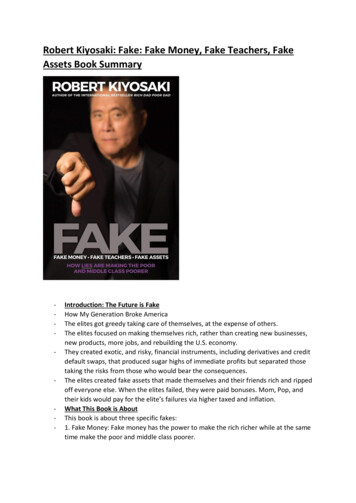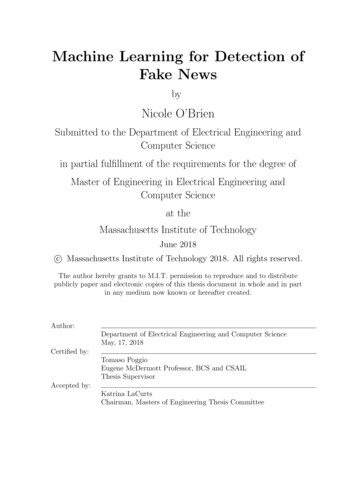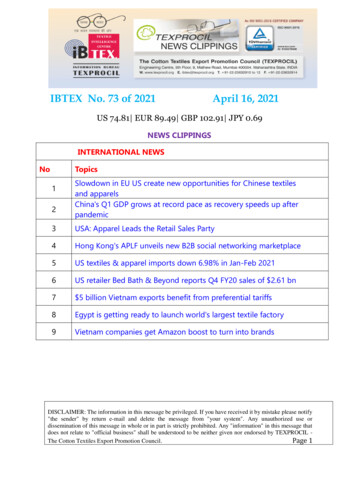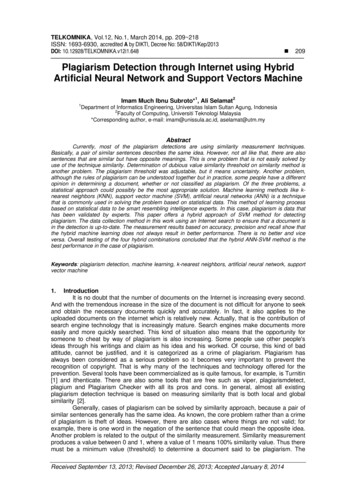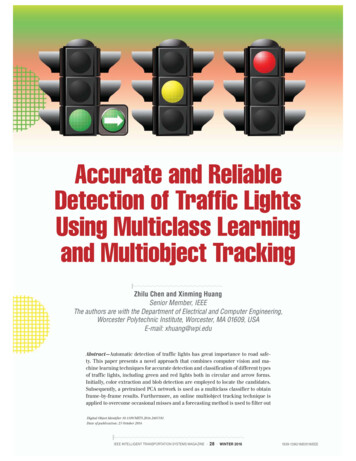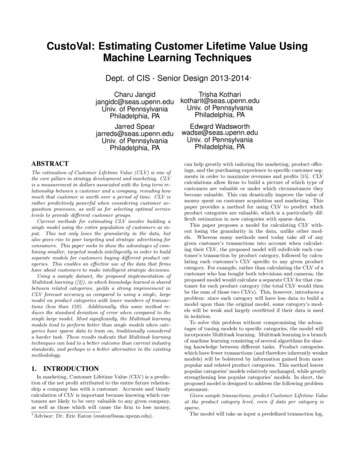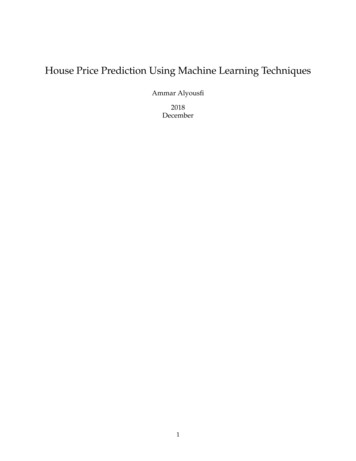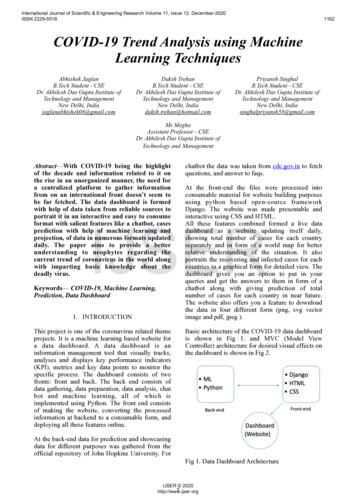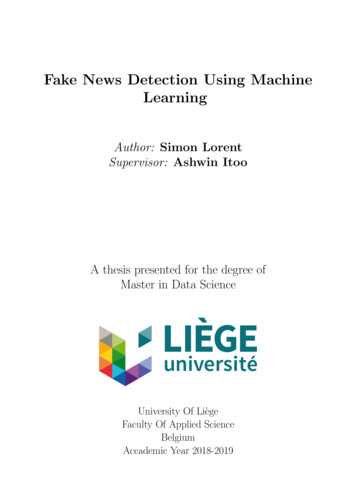
Transcription
Fake News Detection Using MachineLearningAuthor: Simon LorentSupervisor: Ashwin ItooA thesis presented for the degree ofMaster in Data ScienceUniversity Of LiègeFaculty Of Applied ScienceBelgiumAccademic Year 2018-2019
Contents1 Introduction1.1 What are fake news? . . . . . . . . . . . .1.1.1 Definition . . . . . . . . . . . . . .1.1.2 Fake News Characterization . . . .1.2 Feature Extraction . . . . . . . . . . . . .1.2.1 News Content Features . . . . . . .1.2.2 Social Context Features . . . . . .1.3 News Content Models . . . . . . . . . . . .1.3.1 Knowledge-based models . . . . . .1.3.2 Style-Based Model . . . . . . . . .1.4 Social Context Models . . . . . . . . . . .1.5 Related Works . . . . . . . . . . . . . . . .1.5.1 Fake news detection . . . . . . . .1.5.2 State of the Art Text classification1.6 Conclusion . . . . . . . . . . . . . . . . . .777788810101011111112122 Related Work2.1 Introduction . . . . . . . . . . . . . . . . . . . . . . . . . . . . . . . . .2.2 Supervised Learning for Fake News Detection[12] . . . . . . . . . . . .2.3 CSI: A Hybrid Deep Model for Fake News Detection . . . . . . . . . .2.4 Some Like it Hoax: Automated Fake News Detection in Social Networks2.5 Fake News Detection using Stacked Ensemble of Classifiers . . . . . . .2.6 Convolutional Neural Networks for Fake News Detection[19] . . . . . .2.7 Conclusion . . . . . . . . . . . . . . . . . . . . . . . . . . . . . . . . . . . . .[16]. . . .13131314151617173 Data Exploration3.1 Introduction . . . . . . . . . . .3.2 Datasets . . . . . . . . . . . . .3.2.1 Fake News Corpus . . .3.2.2 Liar, Liar Pants on Fire3.3 Dataset statistics . . . . . . . .3.3.1 Fake News Corpus . . .3.3.2 Liar-Liar Corpus . . . .3.4 Visualization With t-SNE . . .3.5 Conclusion . . . . . . . . . . . .20202020212121272729.1.
CONTENTS24 Machine Learning techniques4.1 Introduction . . . . . . . . . . . . . . . . . . . . . . . . . . . . . .4.2 Text to vectors . . . . . . . . . . . . . . . . . . . . . . . . . . . .4.3 Methodology . . . . . . . . . . . . . . . . . . . . . . . . . . . . .4.3.1 Evaluation Metrics . . . . . . . . . . . . . . . . . . . . . .4.4 Models . . . . . . . . . . . . . . . . . . . . . . . . . . . . . . . . .4.4.1 Naı̈ve-Bayes[7] . . . . . . . . . . . . . . . . . . . . . . . . .4.4.2 Linear SVM . . . . . . . . . . . . . . . . . . . . . . . . . .4.4.3 Decision Tree[36] . . . . . . . . . . . . . . . . . . . . . . .4.4.4 Ridge Classifier . . . . . . . . . . . . . . . . . . . . . . . .4.5 Models on liar-liar dataset . . . . . . . . . . . . . . . . . . . . . .4.5.1 Linear SVC . . . . . . . . . . . . . . . . . . . . . . . . . .4.5.2 Decision Tree . . . . . . . . . . . . . . . . . . . . . . . . .4.5.3 Ridge Classifier . . . . . . . . . . . . . . . . . . . . . . . .4.5.4 Max Feature Number . . . . . . . . . . . . . . . . . . . . .4.6 Models on fake corpus dataset . . . . . . . . . . . . . . . . . . . .4.6.1 SMOTE: Synthetic Minority Over-sampling Technique[37]4.6.2 Model selection without using SMOTE . . . . . . . . . . .4.6.3 Model selection with SMOTE . . . . . . . . . . . . . . . .4.7 Results on testing set . . . . . . . . . . . . . . . . . . . . . . . . .4.7.1 Methodology . . . . . . . . . . . . . . . . . . . . . . . . .4.7.2 Results . . . . . . . . . . . . . . . . . . . . . . . . . . . . .4.8 Conclusion . . . . . . . . . . . . . . . . . . . . . . . . . . . . . . .5 Attention Mechanism5.1 Introduction . . . . . . . . . . . . . . . . .5.2 Text to Vectors . . . . . . . . . . . . . . .5.2.1 Word2Vec . . . . . . . . . . . . . .5.3 LSTM . . . . . . . . . . . . . . . . . . . .5.4 Attention Mechanism . . . . . . . . . . . .5.5 Results . . . . . . . . . . . . . . . . . . . .5.5.1 Methodology . . . . . . . . . . . .5.5.2 Liar-Liar dataset results . . . . . .5.5.3 Attention Mechanism . . . . . . . .5.5.4 Result Analysis . . . . . . . . . . .5.5.5 Testing . . . . . . . . . . . . . . . .5.6 Attention Mechanism on fake news corpus5.6.1 Model Selection . . . . . . . . . . .5.7 Conclusion . . . . . . . . . . . . . . . . . 59595961616464646668737373776 Conclusion796.1 Result analysis . . . . . . . . . . . . . . . . . . . . . . . . . . . . . . . . . 796.2 Future works . . . . . . . . . . . . . . . . . . . . . . . . . . . . . . . . . . 79AA.1 TF-IDF max features row results on liar-liar corpus . . . . . .A.1.1 Weighted Average Metrics . . . . . . . . . . . . . . . .A.1.2 Per Class Metrics . . . . . . . . . . . . . . . . . . . . .A.2 TF-IDF max features row results for fake news corpus without. . . . . . . . . . . . .SMOTE.8484848688
CONTENTSB389B.1 Training plot for attention mechanism . . . . . . . . . . . . . . . . . . . . 89
Master thesisFake news detection using machine learningSimon LorentAcknowledgementI would start by saying thanks to my family, who have always been supportive and whohave always believed in me.I would also thanks Professor Itoo for his help and the opportunity he gave me to workson this very interesting subject.In addition I would also thank all the professors of the faculty of applied science for whatthey taught me during these five years at the University of Liège.4
Master thesisFake news detection using machine learningSimon LorentAbstractFor some years, mostly since the rise of social media, fake news have become a societyproblem, in some occasion spreading more and faster than the true information. In thispaper I evaluate the performance of Attention Mechanism for fake news detection ontwo datasets, one containing traditional online news articles and the second one newsfrom various sources. I compare results on both dataset and the results of AttentionMechanism against LSTMs and traditional machine learning methods. It shows thatAttention Mechanism does not work as well as expected. In addition, I made changesto original Attention Mechanism paper[1], by using word2vec embedding, that proves toworks better on this particular case.5
CONTENTS6
Chapter 1Introduction1.11.1.1What are fake news?DefinitionFake news has quickly become a society problem, being used to propagate false or rumourinformation in order to change peoples behaviour. It has been shown that propagation offake news has had a non-negligible influence of 2016 US presidential elections[2]. A fewfacts on fake news in the United States: 62% of US citizens get their news for social medias[3] Fake news had more share on Facebook than mainstream news[4].Fake news has also been used in order to influence the referendum in the United Kingdomfor the ”Brexit”.In this paper I experiment the possibility to detect fake news based only on textual information by applying traditional machine learning techniques[5, 6, 7] as well as bidirectionalLSTM[8] and attention mechanism[1] on two different datasets that contain different kindsof news.In order to work on fake news detection, it is important to understand what is fake newsand how they are characterized. The following is based on Fake News Detection on SocialMedia: A Data Mining Perspective[9].The first is characterization or what is fake news and the second is detection. In orderto build detection models, it is need to start by characterization, indeed, it is need tounderstand what is fake news before trying to detect them.1.1.2Fake News CharacterizationFake news definition is made of two parts: authenticity and intent. Authenticity meansthat fake news content false information that can be verified as such, which means thatconspiracy theory is not included in fake news as there are difficult to be proven true orfalse in most cases. The second part, intent, means that the false information has beenwritten with the goal of misleading the reader.7
CHAPTER 1. INTRODUCTION8Figure 1.1: Fake news on social media: from characterization to detection.[9]Definition 1 Fake news is a news article that is intentionally and verifiable false1.21.2.1Feature ExtractionNews Content FeaturesNow that fake news has been defined and the target has been set, it is needed to analysewhat features can be used in order to classify fake news. Starting by looking at newscontent, it can be seen that it is made of four principal raw components: Source: Where does the news come from, who wrote it, is this source reliable ornot. Headline: Short summary of the news content that try to attract the reader. Body Text: The actual text content of the news. Image/Video: Usualy, textual information is agremented with visual informationsuch as images, videos or audio.Features will be extracted from these four basic components, with the mains featuresbeing linguistic-based and visual-based. As explained before, fake news is used to influence the consumer, and in order to do that, they often use a specific language in orderto attract the readers. On the other hand, non-fake news will mostly stick to a differentlanguage register, being more formal. This is linguistic-based features, to which can beadded lexical features such as the total number of words, frequency of large words orunique words.The second features that need to be taken into account are visual features. Indeed,modified images are often used to add more weight to the textual information. Forexample, the Figure 1.2 is supposed to show the progress of deforestation, but the twoimages are actually from the same original one, and in addition the WWF logo makes itlook like to be from a trusted source.1.2.2Social Context FeaturesIn the context of news sharing on social media, multiple aspect can be taken into account,such as user aspect, post aspect and group aspect. For instance, it is possible to analysethe behaviour of specific users and use their metadata in order to find if a user is at risk
CHAPTER 1. INTRODUCTION9Figure 1.2: The two images provided to show deforestation between two dates are fromthe same image taken at the same time. [10]
CHAPTER 1. INTRODUCTION10of trusting or sharing false information. For instance, this metadata can be its centre ofinterest, its number of followers, or anything that relates to it.Post-based aspect is in a sense similar to users based: it can use post metadata in order toprovide useful information, but in addition to metadata, the actual content can be used.It is also possible to extract features from the content using latent Dirichlet allocation(LDA)[11].1.3News Content Models1.3.1Knowledge-based modelsNow that the different kinds of features available for the news have been defined, it ispossible to start to explain what kinds of models can be built using these features. Thefirst model that relates to the news content is based on knowledge: the goal of this modelis to check the truthfulness of the news content and can be achieved in three differentways (or a mixture of them): Expert-oriented: relies on experts, such as journalists or scientists, to assess thenews content. Crowdsourcing-oriented: relies on the wisdom of crowd that says that if a sufficiently large number of persons say that something is false or true then it shouldbe. Computational-oriented: relies on automatic fact checking, that could be basedon external resources such as DBpedia.These methods all have pros and cons, hiring experts might be costly, and expert arelimited in number and might not be able to treat all the news that is produced. In thecase of crowdsourcing, it can easily be fooled if enough bad annotators break the systemand automatic fact checking might not have the necessary accuracy.1.3.2Style-Based ModelAs explained earlier, fake news usually tries to influence consumer behaviour, and thusgenerally use a specific style in order to play on the emotion. These methods are calleddeception-oriented stylometric methods.The second method is called objectivity-oriented approaches and tries to capture theobjectivity of the texts or headlines. These kind of style is mostly used by partisanarticles or yellow journalism, that is, websites that rely on eye-catching headlines withoutreporting any useful information. An example of these kind of headline could beYou will never believe what he did !!!!!!This kind of headline plays on the curiosity of the reader that would click to read thenews.
CHAPTER 1. INTRODUCTION1.411Social Context ModelsThe last features that have not been used yet are social media features. There are twoapproaches to use these features: stance-based and propagation-based.Stance-based approaches use implicit or explicit representation. For instance, explicitrepresentation might be positive or negative votes on social media. Implicit representationneeds to be extracted from the post itself.Propagation-based approaches use features related to sharing such as the number ofretweet on twitter.1.51.5.1Related WorksFake news detectionThere are two main categories of state of the art that are interesting for this work: previous work on fake news detection and on general text classification. Works on fake newsdetection is almost inexistent and mainly focus in 2016 US presidential elections or doesnot use the same features. That is, when this work focus on automatic features extraction using machine learning and deep learning, other works make use of hand-craftedfeatures[12, 13] such as psycholinguistic features[14] which are not the goal here.Current research focus mostly on using social features and speaker information in orderto improve the quality of classifications.Ruchansky et al.[15] proposed a hybrid deep model for fake news detection making useof multiple kinds of feature such as temporal engagement between n users and m newsarticles over time and produce a label for fake news categorization but as well a score forsuspicious users.Tacchini et al.[16] proposed a method based on social network information such as likesand users in order to find hoax information.Thorne et al.[17] proposed a stacked ensemble classifier in order to address a subproblemof fake news detection which is stance classification. It is the fact of finding if an articleagree, disagree or simply discus a fact.Granik and Mesyura[18] used Naı̈ve-Bayes classifier in order to classify news from buzzfeed datasets.In addition to texts and social features, Yang et al.[19] used visual features such as imageswith a convolutional neural network.Wang et al.[20] also used visual features for classifying fake news but uses adversarialneural networks to do so.
CHAPTER 1. INTRODUCTION12Figure 1.3: Different approaches to fake news detection.1.5.2State of the Art Text classificationWhen it comes to state of the art for text classification, it includes Long short-termmemory (LSTM)[8], Attention Mechanism[21], IndRNN[22], Attention-Based Bidirection LSTM[1], Hierarchical Attention Networks for Text Classification[23], Adversarial Training Methods For Supervised Text Classification[24], Convolutional Neural Networks for Sentence Classification[25] and RMDL: Random Multimodel Deep Learning forClassification[26]. All of these models have comparable performances.1.6ConclusionAs it has been shown in Section 1.2 and Section 1.3 multiple approaches can be usedin order to extract features and use them in models. This works focus on textual newscontent features. Indeed, other features related to social media are difficult to acquire.For example, users information is difficult to obtain on Facebook, as well as post information. In addition, the different datasets that have been presented at Section 3.2 doesnot provide any other information than textual ones.Looking at Figure 1.3 it can be seen that the main focus will be made on unsupervisedand supervised learning models using textual news content. It should be noted thatmachine learning models usually comes with a trade-off between precision and recall andthus that a model which is very good at detected fake news might have a high false positiverate as opposite to a model with a low false positive rate which might not be good atdetecting them. This cause ethical questions such as automatic censorship that will notbe discussed here.
Chapter 2Related Work2.1IntroductionIn this chapter I will detail a bit more, some related works that are worth investigating.2.2Supervised Learning for Fake News Detection[12]Reis et al. use machine learning techniques on buzzfeed article related to US election.The evaluated algorithm are k-Nearest Neighbours, Naı̈ve-Bayes, Random Forests, SVMwith RBF kernel and XGBoost.In order to feed this network, they used a lot of hand-crafted features such as Language Features: bag-of-words, POS tagging and others for a total of 31 differentfeatures, Lexical Features: number of unique words and their frequencies, pronouns, etc, Pyschological Features[14]: build using Linguistic Inquiry and Word Count whichis a specific dictionary build by a text mining software, Semantic Features: Toxic score from Google’s API, Engagement: Number of comments within several time interval.Many other features were also used, based on the source and social metadata.Their results is shown at Figure 2.1.They also show that XGBoost is good for selecting texts that need to be hand-verified,this means that the texts classified as reliable are indeed reliable, and thus reducing theamount of texts the be checked manualy. This model is limited by the fact they do usemetadata that is not always available.Pérez-Rosas et al.[13] used almost the same set of features but used linear SVM as amodel and worked on a different dataset.13
CHAPTER 2. RELATED WORK14Figure 2.1: Results by Reis et al.2.3CSI: A Hybrid Deep Model for Fake News DetectionRuchansky et al.[15] used an hybrid network, merging news content features and metadata such as social engagement in a single network. To do so, they used an RNN forextracting temporal features of news content and a fully connected network in the case ofsocial features. The results of the two networks are then concatenated and use for finalclassification.As textual features they used doc2vec[27].Network’s architecture is shown at Figure 2.2.Figure 2.2: CSI modelThey did test their model on two datasets, one from Twitter and the other one from Weibo,which a Chinese equivalent of Twitter. Compared to simpler models, CSI performs better,with 6% improvement over simple GRU networks (Figure 2.3).
CHAPTER 2. RELATED WORK15Figure 2.3: Results by Ruchansky et al.2.4Some Like it Hoax: Automated Fake News Detection in Social Networks [16]Here, Tacchini et al. focus on using social network features in order to improve the reliability of their detector. The dataset was collected using Facebook Graph API, collectionpages from two main categories: scientific news and conspiracy news. They used logisticregression and harmonic algorithm[28] to classify news in categories hoax and non-hoax.Harmonic Algorithm is a method that allows transferring information across users wholiked some common posts.For the training they used cross-validation, dividing the dataset into 80% for training and20% for testing and performing 5-fold cross-validation, reaching 99% of accuracy in bothcases.In addition they used one-page out, using posts from a single page as test data or usinghalf of the page as training and the other half as testing. This still leads to good results,harmonic algorithm outperforming logistic regression. Results are shown at Figures 2.4and 2.5.Figure 2.4: Results by tacchnini et al.
CHAPTER 2. RELATED WORK16Figure 2.5: Results by tacchnini et al.2.5Fake News Detection using Stacked Ensemble ofClassifiersThorne et al.[17] worked on Fake News Challenge by proposing a stack of different classifiers: a multilayer perceptron with relu activation on average of word2vec for headlineand tf-idf vectors for the article body, average word2vec for headlines and article body,tf-idf bigrams and unigram on article body, logistic regression with L2 regularization andconcatenation of word2vec for headlines and article body with MLP and dropout.Finally, a gradient boosted tree is used for the final classification.Figure 2.6: Results by Thorne et al.
CHAPTER 2. RELATED WORK2.617Convolutional Neural Networks for Fake NewsDetection[19]Yang et al. used a CNN with images contained in article in order to make the classification. They used kaggle fake news dataset1 , in addition they scrapped real news fromtrusted source such as New York Times and Washington Post.Their network is made of two branches: one text branch and one image branch (Figure2.7). The textual branch is then divided of two subbranch: textual explicit: derivedinformation from text such as length of the news and the text latent subbranch, which isthe embedding of the text, limited to 1000 words.Figure 2.7: TI-CNNThe image branch is also made of two subbranch, one containing information such asimage resolution or the number of people present on the image, the second subbranch usea CNN on the image itself. The full details of the network are at Figure 2.8. And theresults are at Figure 2.9 and show that indeed using images works better.2.7ConclusionWe have seen in the previous sections that most of the related works focus on improvingthe prediction quality by adding additional features. The fact is that these features arenot always available, for instance some article may not contain images. There is also thefact that using social media information is problematic because it is easy to create a newaccount on these media and fool the detection system. That’s why I chose to focus onthe article body only and see if it is possible to accurately detect fake news.1https://www.kaggle.com/mrisdal/fake-news
CHAPTER 2. RELATED WORKFigure 2.8: TI-CNNFigure 2.9: TI-CNN, results18
CHAPTER 2. RELATED WORK19
Chapter 3Data Exploration3.1IntroductionA good starting point for the analysis is to make some data exploration of the data set.The first thing to be done is statistical analysis such as counting the number of texts perclass or counting the number of words per sentence. Then it is possible to try to get aninsight of the data distribution by making dimensionality reduction and plotting data in2D.3.23.2.1DatasetsFake News CorpusThis works uses multiple corpus in order to train and test different models. The maincorpus used for training is called Fake News Corpus[29]. This corpus has been automatically crawled using opensources.co labels. In other words, domains have been labelledwith one or more labels in Fake News Satire Extreme Bias Conspiracy Theory Junk Science Hate News Clickbait Proceed With Caution Political Credible20
CHAPTER 3. DATA EXPLORATION21These annotations have been provided by crowdsourcing, which means that they mightnot be exactly accurate, but are expected to be close to the reality. Because this worksfocus on fake news detection against reliable news, only the news labels as fake andcredible have been used.3.2.2Liar, Liar Pants on FireThe second dataset is Liar, Liar Pants on Fire dataset[30], which is a collection oftwelve thousand small sentences collected from various sources and hand labelled. Theyare divided in six classes: pants-fire false barely-true half-true mostly-true trueThis set will be used a second test set. Because in this case there are six classes againsttwo in the other cases, a threshold should be used in order to fix which one will be considered as true or false in order to be compared with the other dataset.It should be noted that this one differs from the two other datasets is it is composed onlyon short sentences, and thus it should not be expected to have very good results on thisdataset for models trained on Fake News Corpus which is made of full texts. In addition,the texts from the latest dataset are more politically oriented than the ones from the firstone.3.3Dataset statistics3.3.1Fake News CorpusGeneral AnalysisBecause Fake News Corpus is the main dataset, the data exploration will start withthis dataset. And the first thing is to count the number of items per class. Before startingthe analysis, it is needed to clean up the dataset. As it is originally given in a large 30GBCSV file, the first step is to put everything in a database in order to be able to retrieveonly wanted a piece of information. In order to do so, the file has been red line by line.It appears that some of the lines are badly formated, preventing them from being readcorrectly, in this case they are dropped without being put in the database. Also, eachline that is a duplicate of a line already red is also dropped. The second step in cleaningthe set consists of some more duplicate removal. Indeed, dropping same lines removeonly exact duplicate. It appears that some news does have the same content, with slightvariation in the title, or a different author. In order to remove the duplicate, each text ishashed using SHA256 and those hash a compared, removing duplicates and keeping only
CHAPTER 3. DATA EXPLORATION22one.Because the dataset has been cleaned, numbers provided by the dataset creators andnumber computed after cleaning will be provided. We found the values given at Table3.1. It shows that the number of fake news is smaller by a small factor with respect tothe number of reliable news, but given the total number of items it should not cause anyproblems. But it will still be taken into account later on.Provided ComputedTypeFake News928, 083770, 287146, 080855, 23SatireExtreme Bias1, 300, 444771, 407905, 981495, 402Conspiracy TheoryJunk Science144, 93979, 342117, 37465, 264Hate NewsClickbait292, 201176, 403319, 830104, 657Proceed With CautionPolitical2, 435, 471972, 283Credible1, 920, 139 1, 811, 644Table 3.1: Number of texts per categoriesIn addition to the numbers provided at Table 3.1, there are also two more categoriesthat are in the dataset but for which no description is provided: Unknown: 231301 Rumour: 376815To have a better view of the distribution of categories, a histogram is provided at Figure3.1.In addition, the number of words per text and the average number of words per sentenceshave been computed for each text categories. Figure 3.2 shows the boxplots for thesevalues. It can be seen that there is no significative difference that might be used in orderto make class prediction.Before counting the number of words and sentences, the texts are preprocessed usinggensim[31] and NLTK[32]. The first step consists of splitting text into an array of sentences on stop punctuation such as dots or questions mark, but not on commas. Thesecond step consists of filtering words that are contained in these sentences, to do so,stop words (words such as ’a’, ’an’, ’the’), punctuation, words or size less or equal totree, non-alphanumeric words, numeric values and tags (such as html tags) are removed.Finally, the number of words still present is used.An interesting feature to look at is the distribution of news sources with respect to theircategories. It shows that in some case some source a predominant. For instance, lookingat Figure 3.3 shows that most of the reliable news are from nytimes.com and in thesame way, most of the fake news is coming from beforeitsnews.com. That has to be taken
CHAPTER 3. DATA alfakehateclickbaitconspiracybias0typeFigure 3.1: Histogram of text distribution along their categories on the computed numbers.(a) Boxplot of average sentence lengthfor each category.(b) Boxplot of number of sentences foreach category.Figure 3.2: Summary statistics
af.reuters.comabcnews.go.com de. u.news.yahoo.comau. nance.yahoo.comau.be.yahoo.com edition.cnn.comindianexpress.com domainswww.forbes.com earpolitics.comusaphase.com usapoliticszone.comusanews ash.comusa rstinformation.com usa-television.comuniversepolitics.com(d) Fakethreepercenternation.com1,600,000www.n .com www.nhl.com(b) bcnews.comthenet24h.comthene
mation by applying traditional machine learning techniques[5, 6, 7] as well as bidirectional-LSTM[8] and attention mechanism[1] on two di erent datasets that contain di erent kinds of news. In order to work on fake news detection, it is important to und
